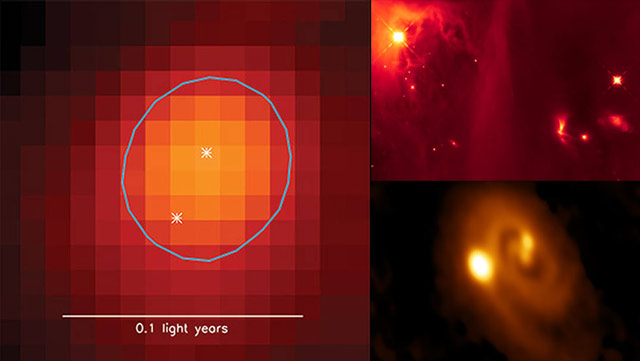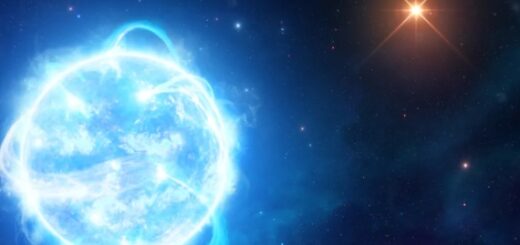Scientists Find New Evidence That Our Solar System May Have TWO Suns – Nibiru/ Nemesis

According to experts, there is evidence which suggests that all stars in the universe are born in pairs.
For decades, scientists have speculated that our sun has an ‘evil’ twin referred to as NEMESIS — a dwarf star responsible for hurling objects from the outer solar system towards our planet.
In fact, NEMESIS may even have been resposnible for mass extinctions that have rocked Earth for millions of years.
Left image: Radio image of a young binary system. Lower Right: Image of a triple star system formed from a disk of dust.
All detected in the molecular cloud of Perseus. Upper right: Binary system located in the region IC 348 where the two stars interact by emitting pulses of light.
Astronomers use the term binary system to refer to two stars that are so close together that they orbit around a common center of mass.
This is something quite frequent in the Universe, which has motivated some researchers to question if our Sun could ever be part of one of these systems.
Now a team of researchers from the Universities of Harvard and Berkeley has conducted a study whose results suggest that all stars are born forming binary systems and that ours would not be an exception.
In fact, many stars in the universe have faithful companions, something that we can observe if we look at our nearest galactic neighbor, Alpha Centauri—a solar system which consists of three stars:
Alpha Centauri A and Alpha Centauri B, which form the binary star Alpha Centauri AB (also named Rigil Kentaurus), and a small and faint red dwarf, Alpha Centauri C (also named Proxima Centauri).
Inspired by this fact, astronomers have analyzed a hypothesis formulated decades ago by physicist R. A. Muller, which suggests that our Sun has an undetected partner, called Nemesis, capable of generating disturbances in the Oort cloud with devastating consequences for the inner parts of our solar system.
In fact, this would even explain the deadly cycle of mass extinctions that occurs every 27 million years.
Back in the 1980s, experts noticed that mass extinction events on our planet—like the one which is believed to have wiped out the dinosaurs—seemed to follow a cyclical pattern.
After several studies, scientists were able to calculate that mass extinctions on Earth occur every 27 million years.
This raised numerous questions and the long pauses between events made them turn towards the universe to look for an explanation.
Then, a scientist called Richard Muller, from the University of California Berkley, proposed that the perpetrator could be a twin of the sun dwelling 1.5 light-years away.
While no evidence has ever been found that Nemesis exists, a new study has offered a glimpse of hope by proving that all stars and even our sun are born with a twin, meaning that somewhere out there, our solar system’s second Sun may still lurk undetected.
According to news.berkeley.edu, the new assertion is based on a radio survey of a giant molecular cloud filled with recently formed stars in the constellation Perseus, and a mathematical model that can explain the Perseus observations only if all sunlike stars are born with a companion.
This is a radio image of a very young binary star system, less than about one million years old, that formed within a dense core (oval outline) in the Perseus molecular cloud.
“We are saying, yes, there probably was a Nemesis, a long time ago,” said co-author Steven Stahler, a UC Berkeley research astronomer.
“We ran a series of statistical models to see if we could account for the relative populations of young single stars and binaries of all separations in the Perseus molecular cloud, and the only model that could reproduce the data was one in which all stars form initially as wide binaries.
“These systems then either shrink or break apart within a million years.”
In the recently published work experts refer to “wide binaries” as two stars separated by more than 500 astronomical units, or UA, where an astronomical unit is the average distance between the Sun and Earth (93 million miles).
Experts explain that a wide binary companion to our sun would have been 17 times farther from the sun than its most distant planet today, Neptune.
Based on this model, the sun’s sibling most likely escaped and mixed with all the other stars in our region of the Milky Way galaxy, never to be seen again.
“The idea that many stars form with a companion has been suggested before, but the question is: how many?” said first author Sarah Sadavoy, a NASA Hubble fellow at the Smithsonian Astrophysical Observatory.
“Based on our simple model, we say that nearly all stars form with a companion. The Perseus cloud is generally considered a typical low-mass star-forming region, but our model needs to be checked in other clouds.”
Sources: Ancient-Code.com; News.Berkeley.edu; Phys.org



 Creators of mankind
Creators of mankind Description of “Tall white aliens”
Description of “Tall white aliens” Where they came from?
Where they came from? About hostile civilizations
About hostile civilizations The war for the Earth
The war for the Earth “Tall white aliens” about eternal life
“Tall white aliens” about eternal life Video: “Nordic aliens”
Video: “Nordic aliens” Aliens
Aliens Alien encounters
Alien encounters The aliens base
The aliens base UFO
UFO Technology UFO
Technology UFO Underground civilization
Underground civilization Ancient alien artifacts
Ancient alien artifacts Military and UFO
Military and UFO Mysteries and hypotheses
Mysteries and hypotheses Scientific facts
Scientific facts


















